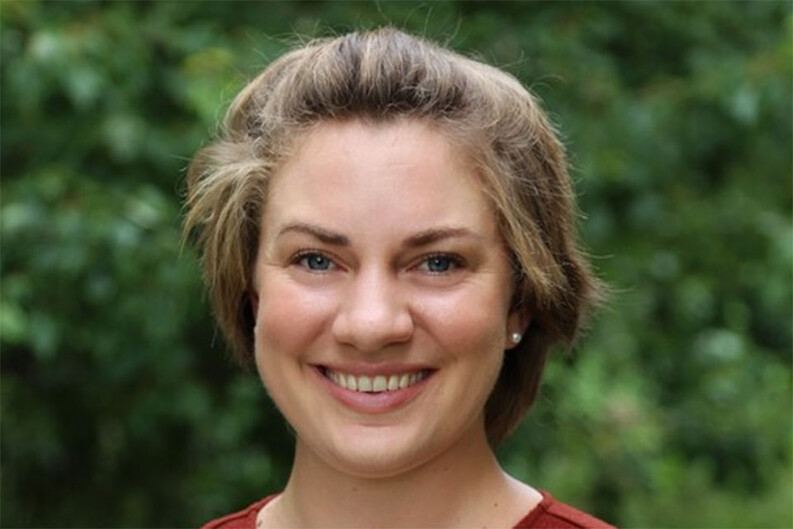Q&A: Hope Bigda-Peyton YSE ’20, on State-Level Biogas Legislation and Environmental Justice

Last spring, Hope Bigda-Peyton, Yale School of the Environment ’20, was part of the inaugural cohort of graduate and professional school students who participated in the Law, Ethics & Animal Program’s Climate, Animal, Food, and Environmental Law & Policy Lab (CAFE Lab). CAFE Lab challenges teams of students to develop novel strategies to compel industrial food producers to account for externalities in the agricultural system that impact people, animals, and the environment. As part of her work for the Lab, Bigda-Peyton was one of five coauthors of a report titled, “Let’s Talk About Biogas…Even If We Think It Stinks,” which explored the kinds of state policy interventions that could support the growth of anaerobic digester technology, which promises to reduce greenhouse gas emissions from industrial livestock operations, while avoiding the expansion of unsustainable forms of intensive livestock production. In April, Bigda-Peyton and her team pitched their paper to a panel of leading advocates, philanthropists, food industry experts, and scholars. LEAP Editorial Associate Jack McCordick, B.A. ’22, spoke with Bigda-Peyton about her research.
The paper acknowledges that the most relevant authority for the regulation and development of biogas exists at the state, not federal, level. Do you see that as an opportunity or an obstacle for advocates and policymakers looking to ensure that anaerobic digester technology is implemented across the country with an eye to public health, environmental impacts, workers’ rights, and animal welfare?
In the current context, I would see state regulatory authority for biogas development as an opportunity because states looking to use this technology can shape its deployment in the most sustainable ways possible that are also beneficial for people and animals. For example, states can restrict some biogas to on-farm use or tie funding for biogas to environmental permitting. So, there are some models out there that states looking to fund biogas can use for inspiration. Federal programs that support biogas and anaerobic digestion like REAP [Rural Energy for America Program] could also expand in the future with increased domestic ambition for a renewable energy transition to address climate change.
In the paper, you and your coauthors note that anaerobic digesters (ADs) “are primarily adopted on confined animal feeding operations (CAFOs) which pose a number of well-documented threats to public health and the environment besides methane emissions.” You also note that because AD technology entails significant economies of scale, without proper mitigation strategies, the technology may end up only being available to larger farms. What kinds of policy interventions might avoid those outcomes?
Biogas is not necessarily financially viable without state subsidies or support as anaerobic digestion technology is quite expensive. This is particularly true for smaller farms with limited access to capital. If you compare this to wastewater treatment plants, there’s a long history in the United States of taxpayer dollars going to fund wastewater and sewage treatment for human populations to mitigate environmental and public health hazards. That same investment has not been made to manage the manure produced by CAFOs, which is an important reason why we see resulting environmental and public health harms. The question of investment and making the externalities of manure management visible is important. Some state-level policy interventions to incentivize improved manure management and allow smaller farms access to anaerobic digestion technology include environmental permitting, state subsidies, renewable portfolio standards, and tax policy.
For me, one of the key findings of our research was the need for information transparency and disclosure. There’s a great NRDC report that came out last year in collaboration with the Yale Environmental Protection Clinic that addresses the difficulty of finding information about CAFOs and manure management, from location to details on the manure management of different operations. Tying any sort of taxpayer-funded subsidization of anaerobic digestion to information transparency and disclosure should be step one. Step two is to have that funding — whether in the form of tax incentives, subsidies, grants, or loans — be constrained to operations that meet environmental standards more rigorously, that have improved practices for animal welfare, worker standards, environmental justice and community impacts.
The paper acknowledges that “Social justice and animal welfare advocates argue that the promotion of ADs will not only increase CAFOs’ social license to operate, but will divert resources from more sustainable methods of emissions reduction and, through investment in infrastructure, lock in future reliance on this harmful form of animal production. In their view, ADs are nothing but greenwashing and should be opposed.” What is your response to these criticisms?
It's a thorny issue. There are opinions on both sides, and our goal with the paper was to see whether there’s a middle ground approach that acknowledges the utility of anaerobic digestion technology while balancing potential harms. We know that enteric fermentation and manure management make up 42 percent of U.S. agricultural GHG emissions, and that agriculture as a sector accounts for 9.3 percent of U.S. greenhouse gas emissions. This is a huge problem, and anaerobic digestion technology can help farmers capture methane and address climate change.
On the other hand, we acknowledge that CAFOs pose challenges to worker welfare, environmental health, and animal welfare. CAFOs can increase farm worker exposure to workplace-related hazards. In terms of environmental health, anaerobic digestion does not address the issue of manure management as a whole. Byproducts resulting from anaerobic digestion are still a source of nitrogen and phosphorous at a scale that can contaminate air, soil, and water if not managed appropriately and together with other agricultural soil management practices account for the largest source of U.S. agricultural GHG emissions (application of managed livestock manure is part of agricultural soil management which makes up 55 percent of U.S. agricultural GHG emissions). Animal welfare in confined conditions is also a concern. Therefore, advocates are arguing against creating a financial incentive that would make these types of operations a permanent part of the U.S. grid and energy supply.
Our perspective was to explore a middle ground approach that acknowledges both of these viewpoints and addresses the question: if we are going to have CAFOs, how can these operations be most sustainably managed? And that’s where we came up with the idea of having state subsidies, tax incentives, renewable portfolio standards, and financial support tied to cooperative digester models and smaller scale operations that support family farms and constrain energy use to on-farm and local use. This pathway would allow for use of AD technology to support operations that meet environmental standards and incorporate animal welfare, worker wellbeing, and environmental justice.
Since the report came out last spring, you’ve spent your summer expanding on your biogas research from the CAFE lab. What have you been doing?
My summer research entailed digging deeper into state laws and creating a database of the different energy laws that relate to biogas across the United States. Having that as a tool and a resource for biogas researchers is an important start, because the legislation varies significantly across states. There are some states that don’t have any legislation, but about two-thirds do. States refer to biogas with a number of different names — from “renewable natural gas” to “biomethane” to “waste energy” and more. I combed through different state legislation to understand the mechanisms and levers that states are using to either promote or constrain the use of biogas.
I mentioned earlier that there are some state with laws to constrain the use of biogas to ensure sustainable use of the resource, but there are other states looking to expand biogas. I would flag Washington and Oregon, which have ambitious goals to increase the use of biogas as part of their Renewable Portfolio Standards.
I was also working on consolidating state level approaches based on these laws and the tools that we laid out in our previous white paper. I looked at New York, North Carolina, and California, three states that have different approaches to biogas but all have significant animal agriculture and stand to benefit from thinking about ways to make biogas as sustainable as it could be.
Pedagogically, the goal of the CAFE lab is to introduce students into the world of policy advocacy. How did knowing that you would be pitching your to a idea panel of leading advocates, philanthropists, food industry experts, and scholars shape your research and writing?
The CAFE lab approach prompted us to think about how we could have a tangible intervention in this space given the momentum at both the federal and state level. For us, a big focus became thinking about how to move past the language some groups are using to see what’s really happening on the ground. Data disclosure and transparency is important, as well as the words used to describe what is happening in food and agriculture systems such as “renewable natural gas.” The CAFE lab prompted us to balance four areas — animal welfare, worker well-being, environmental health, and climate change — within what is politically feasible, which motivated our approach in identifying state levers for change.
How has being part of the CAFE Lab and being part of YLS’s Law, Ethics & Animals Program shaped your future ambitions and interests?
I’ve been interested in agriculture as a pathway for sustainable development for a long time, and worked in this area before coming to Yale to do my degree in environmental management. LEAP was pivotal in my understanding of the impacts of animal agriculture in the United States. I had previously only looked at the issue from an environmental health perspective, but LEAP prompted me to explore the intersection between animal agriculture and climate change while adding in animal welfare and workers’ rights. Incorporating those angles added nuance to my perspective and was an important exercise in weighing trade-offs that will continue to inform my future work.


